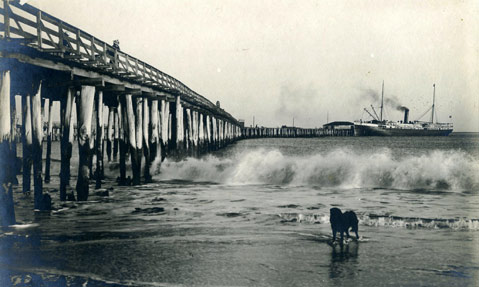Eucalyptus Trees
The Australian Import was Brought to Santa Barbara by Ellwood Cooper in 1872

Eucalyptus was first brought into California in 1869 and was first successfully planted in any significant numbers in the Riverside area. Goleta Valley rancher Ellwood Cooper introduced eucalyptus here in 1872 and by the mid 1870s had planted some 50,000 trees of more than 50 varieties.
Cooper was an innovative horticulturist and enterprising entrepreneur. He introduced walnuts as a cash crop to the South Coast and became one of the country’s largest producers of walnuts. Almonds were another venture, and he also planted more than 250 acres of olives. For a time, he produced and marketed his own olive oil, but cheaper oils from Europe pushed him out of the business.
Cooper was innovative in other ways, as well. When his almond crop was threatened by an insect infestation, he responded by importing from Asia a type of ladybug that consumed the pests and saved his trees from destruction.
As for eucalyptus, Cooper hoped that it would become a staple source of lumber, as the trees thrived in this climate. The wood’s grain, however, made sawing and shaping it difficult, rendering it unsatisfactory as a construction material. Still, eucalyptus proved useful for railroad ties and in wharf pilings. John Stearns, owner of Stearns Wharf, took notice.
In the late 1880s, Stearns, a resourceful businessman, experimented with eucalyptus. Owner of a lumber company and unhappy with Santa Barbara’s lack of a deepwater pier, Stearns had secured the financial backing to build his own wharf in 1872. He had then met the challenge thrown down by the owners of the shorter Chapala Street Pier and eventually drove them out of business.
Stearns may have owned the only wharf in town, but income flow remained inconsistent. Maintenance and repair costs were high; already the wharf had been wrecked once in a storm. Stearns cast around for a way to cut costs and hit upon the use of eucalyptus for pilings as a possibility. Cooper was a friend of his, and he undoubtedly attended at least one of Cooper’s lectures on the wonders of this import from Australia.
Beginning in 1888, Stearns began to replace old wharf pilings with eucalyptus. By the end of 1891, about 350 of the wharf’s supports were of eucalyptus. Stearns had high hopes that these pilings would prove resistant to the corrosive effects of salt water and drifting sand. Pilings of redwood or fir had a life of anywhere between four to seven years. Stearns hoped to get as much as 15 years out of eucalyptus supports.
The results were mixed at best. Eucalyptus lasted about as long as the traditional alternatives. Although costing slightly less than redwood or fir, the “blue gum” pilings were difficult to work with. They were hard to cut and trim; they cracked and often did not hold their shape. They also proved susceptible to sea creatures that bored into the wood. Stearns concluded that the experiment was a failure and he returned to other hardwoods to effect wharf repairs.
A few other wharf owners in California, largely following Stearns’s lead, used eucalyptus for a time. A U.S. Department of Agriculture bulletin in 1902 gave eucalyptus a positive report, but actual results belied its findings. In short, eucalyptus and ocean water made a poor mix.



